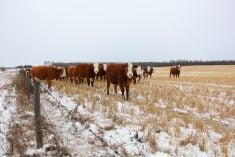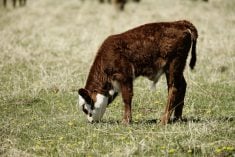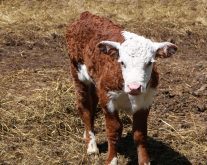With calving season in full swing for many ranchers across the Prairies, producers are often dealing with a lot of different challenges — snow, rain, and sometimes, calves that end up orphaned.
Abby-Ann Redman, a ruminant nutritionist with Blue Rock Animal Nutrition, says when a rancher ends up with an orphaned calf, the most important thing is to get colostrum into it as soon as possible.
Read Also

Body condition, nutrition and vaccination for brood cows
One of the remarkable events of the past century related to ranching has been the genetic evolution of brood cows….
[Related] Western Producer: Understanding the ‘what’ and ‘how’ of colostrum for calves
“If the calf hasn’t had any, it’s priority number one,” Redman says. “So in an ideal world, the calf would receive five to six per cent of their body weight in the first six hours of colostrum. And then if the producer is seeing that, then they would do that again 12 hours later. So it’s really important to make sure that the quantity and the timing are consistent.”
To make having an orphan calf easier for the producer, Redman says finding a cow who would be willing to adopt the calf would be less time-consuming and also cheaper for the rancher.
There are other benefits for the calf, as well.
“If you can get the calf onto another cow, that’s ideal,” she says. “Weaning weights would probably be higher if you can graft that calf on.”
Pairing the calf with a cow has other benefits, such as having a cow to fend off predators in pasture, she adds.
“Grazing grass is a learned behaviour for calves as well. So, if you can get the calf onto a cow, it’ll pick up how to graze faster, rather than a bottle-fed calf that just doesn’t really have a mom to show it what to do.”
However, if a producer has no option but to bottle feed, Redman says they can still efficiently raise a calf. Though it’s common for bottle-fed calves to fall behind their weaning weight, feeding them at least 70 grams of colostrum powder in their milk replacer for two weeks should keep them up to speed.
When bottle feeding, Redman says if the calf is having trouble sucking, producers should make sure the rubber on the nipple isn’t too rigid. Nipples should also be full-sized so milk flows.
“Just having that milk running down the throat can help start that suckle reflex.”
While some producers on social media say that things like honey on the nipple can make calves suck better, Redman says there isn’t much scientific merit behind that.
She also says grain intake should be monitored before they are weaned off milk. Redman recommends weaning slowly off milk after calves are consuming 1.5 to two pounds of dry feed.
When orphan calves start on forage, Redman says there isn’t much difference between a calf with a mother and an orphan calf, as long as the orphan calf was weaned off milk properly.
“The rumen does need time to adapt and grow the microbial population that it will need to digest that forage,” Redman says. “So making sure they have the green and the hay out even a couple of days after the calf is born. So just let them pick at it. And then as long as that consumption is up around that 1.5 to two pounds, then the rumen will be functioning well enough that they could go exclusively out to that.”

















